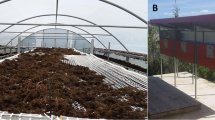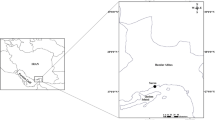Summary
Investigations have been undertaken into the manurial values of two New Zealand seaweed species,Pachymenia himantophora (Rhodophyceae) andDurvillea antarctica (Phaeophyceae). Chemical analyses have shown thatDurvillea is richer thanPachymenia in cations and chloride but poorer in nitrogen and sulphur. When applied to soil in the form of dry mealPachymenia was found to stimulate the growth of tomato seedlings on some soils and depress it on others;Durvillea, on the other hand, depressed growth on all the soil types used. Experiments indicated that the salts contained in the seaweeds were not harmful to plant growth.
Pachymenia may be inhibitory to plant growth on some soils through causing a greatly increased manganese uptake and there was an indication that in treated soils the level of available phosphate was lowered, at least initially.Durvillea is thought to induce nitrogen deficiency in soils by virtue of its high C/N ratio; this is, however, unlikely to be the sole factor responsible.
Effects of seaweeds on soil conditions are complex and can involve many factors: the manurial values of a species cannot be judged solely on its mineral analysis.
Similar content being viewed by others
Literature Cited
Francki, R. I. B., Studies in manurial values of seaweeds II. Effects ofPachymenia himantophora andDurvillea antarctica on the immobilisation of nitrogen in soil. Plant and Soil12, 311–323 (1960).
Garey, C. L., and Barber, S. A., Evaluation of certain factors involved in increasing manganese availability with sulphur. Soil Sci. Soc. Am. Proc.16, 173–175 (1952).
Hewitt, E. J., Sand and water culture methods used in the study of plant nutrition. Commonwealth Bur. Hort. Plantation Crops Gt. Brit. Tech. Commun. No.22 (1952).
Kaila, A., Biological absorption of phosphorus. Soil Sci.68, 279–289 (1949).
Page, J. B., and Bodman, G. B., The effect of soil physical properties on nutrient availability.In: Mineral Nutrition of Plants (Ed. E. Truog). The University of Wisconsin Press (1953).
Parbery, N. H., and Swaby, R. J., Organic materials in supplying nitrogen to crops. Agr. Gaz. N. S. Wales53, 357–361 (1942).
Plice, K. J., Some effects of salt water on soil fertility. Soil Sci. Soc. Am. Proc.14, 275–278 (1949).
Richards, L. A., Diagnosis and improvement of saline and alkali soils. U.S. Dept. Agr. HandbookNo. 60, (1954).
Sherman, G. D., McHargne, J. S., and Hangeman, R. H., The influence of halides on the oxidation of manganese in soils. Soil Sci.56, 127–134 (1943).
Winsor G. W., Mineralisation and immobilisation of nitrogen in soil. J. Sci. Food Agr.9, 792–801 (1958).
Author information
Authors and Affiliations
Rights and permissions
About this article
Cite this article
Francki, R.I.B. Studies in manurial values of seaweeds. Plant Soil 12, 297–310 (1960). https://doi.org/10.1007/BF02232987
Received:
Issue Date:
DOI: https://doi.org/10.1007/BF02232987




